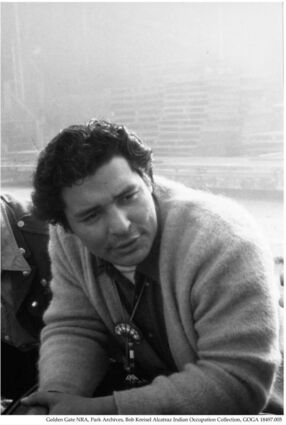Nearly 50 years ago an Akwesasronon man was shot in the chest
The accused was acquitted by all-white jury
By Kaniehtonkie.
Richard Oakes was shot at close range in the chest on September 20, 1973. The man who shot Oakes, Michael Morgan was charged with voluntary manslaughter and later acquitted by an all-white jury. Morgan claims he shot Oakes in self-defense. Oakes was 30 years old at the time of his death.
During the trial, and according to testimony given a month later by Frank Owen Greer, a San Francisco visitor to the camp, Morgan allegedly said Oakes was a "troublemaker" who was "half-crazy and that he'd be better off dead."
During his short life, Oakes had established a reputation as an activist, a man who cared deeply about his people and on any protest or action, Oakes always acted peacefully.
Oakes was 27 when he led a group of Native Americans to occupy Alcatraz Island. Led by Akwesasne Mohawk Richard Oakes and LaNada WarJack, along with fourteen American Indian student activists they initiated the takeover on November 9, 1969. On November 20, 1969, an additional eighty-nine Indian occupiers that included entire families, joined them on the island.
The activists relied on federal policy and a provision of the 1868 Treaty of Fort Laramie that authorized Indians to settle land unused by the federal government. Alcatraz, formerly a federal prison, was closed under the Kennedy administration in 1963; therefore, the unused land fell under the provision of the Treaty that provided for resettlement by Indians. The students seized the land not only as a political statement, but a cultural one. They sought to develop an environmental and cultural center and a school that would allow them to teach native languages and customs to preserve the cultural heritage that had been denied them by government programs that practiced forced assimilation.
The takeover and occupation, which attracted a groundswell of support from across the nation, lasted nineteen months ending on June 11, 1971. The activists asserted their resolve for self-determination. During this time, there was a marked increase of American Indian militancy across the nation that attracted the attention of President Nixon. Nixon later signed fifty-two legislative measures to reform some of the grievances addressed by the protestors such as the Indian Termination Act of 1953, which ended federal recognition of Indian tribes, disbanded tribes, and allowed tribal land to be confiscated and sold. His successor, Gerald Ford, championed Nixon's last piece of legislation, The Indian Self-Determination, and Education Assistance Act, which was signed in 1975.
According to the Park Service while the overt aims of the occupation were never realized, the Park Service explains that something else was achieved with Oakes' efforts:
"The success or failure of the occupation should not be judged by whether the demands of the occupiers were realized. The underlying goals of the Indians on Alcatraz were to awaken the American public to the reality of the plight of the first Americans and to assert the need for Indian self-determination. As a result of the occupation, either directly or indirectly, the official government policy of termination of Indian tribes was ended and a policy of Indian self-determination became the official US government policy."
Years later, countless Native Americans and First Nation peoples have been murdered with impunity. And today still, Native Americans continue to fight for a greater voice on the political stage. Major environmental issues, nation sovereignty, and the ongoing disappearances of Native American - First Nation women continue to be a pervasive threat with no end in sight.





Reader Comments(0)